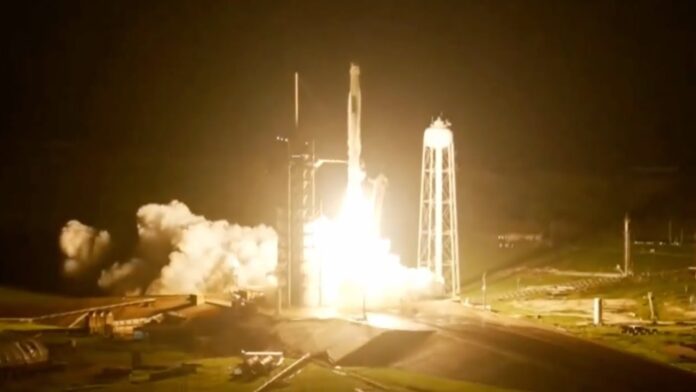Jared Isaacman and his crew venture into space, aiming to conduct the first-ever spacewalk by private citizens and push the boundaries of non-professional space exploration
On September 10, 2024, a SpaceX Falcon 9 rocket launched from Florida, marking a significant milestone in space exploration as a crew of four civilians embarked on a mission to perform the first private spacewalk in history. The mission, known as Polaris Dawn, is led by billionaire tech entrepreneur Jared Isaacman, who previously funded a private spaceflight in 2021.
The team includes two SpaceX engineers, Sarah Gillis and Anna Menon, alongside former Air Force pilot Scott “Kidd” Poteet. After more than two years of extensive training, they are prepared to not only venture beyond the typical bounds of civilian space travel but to break new ground in space exploration.
Their mission is unique in that it aims to surpass previous Earth-lapping records, flying to an altitude of 870 miles, much higher than the International Space Station, and nearing the distance covered by NASA’s Gemini project in 1966. This flight will also see the testing of newly designed spacewalking suits, which will allow Isaacman and Gillis to exit the Dragon capsule for a brief spacewalk, marking the first time private citizens will conduct such an activity.
Unlike traditional spacewalks performed by professional astronauts, Isaacman and Gillis will remain tethered to the capsule, testing the flexibility and durability of the suits in the vacuum of space. Their movements will be limited to staying close to the craft, avoiding the more dramatic displays such as jetpack-assisted floating. The entire Dragon capsule will be depressurized during this exercise, exposing the crew to the same environmental dangers faced by seasoned astronauts.
Spacewalks, regarded as one of the riskiest aspects of space missions, have so far only been conducted by trained professionals from NASA, the Soviet Union, and other space agencies. The Polaris Dawn mission signifies a new chapter, allowing non-professional astronauts to engage in these critical tasks.
The crew will spend five days in orbit, during which they will monitor radiation levels, test new communication systems, and conduct various scientific experiments aimed at preparing for future deep-space missions. After completing their mission, they will return to Earth with a splashdown off the coast of Florida.
This mission is the first of three that Isaacman has committed to with SpaceX, reflecting a broader vision of expanding private space exploration and advancing technologies that could support future human missions to the Moon and Mars.
Analysis:
- Political:
The Polaris Dawn mission illustrates the growing involvement of private enterprises in what was once a domain reserved exclusively for governments. By opening space to civilian participants, missions like this shift the paradigm of space exploration from national pride to commercial ventures. As SpaceX demonstrates the feasibility of private spaceflights, other companies may follow, leading to regulatory debates about safety standards, international cooperation, and space governance. The mission also reinforces the United States’ position as a leader in space innovation, with SpaceX setting new precedents for civilian space endeavours. - Social:
Polaris Dawn contributes to ongoing societal discussions about the democratization of space travel. Space has historically been an elite frontier, with access limited to highly trained astronauts or the super-wealthy. As private companies like SpaceX continue to develop missions for non-professionals, space travel could eventually become more accessible. However, this raises questions about who benefits from such advancements. Will the average person ever afford space travel, or will it remain a playground for the rich? The mission also engages the public imagination, fueling interest in science, technology, and the possibilities of human expansion into space. - Racial:
While the Polaris Dawn mission reflects a broader trend toward inclusivity in space exploration, it also highlights the challenges of ensuring diversity in an industry historically dominated by white men. SpaceX has made efforts to involve more women and minorities in its space programs, as seen with the inclusion of Anna Menon, a SpaceX engineer, on the Polaris Dawn team. However, broader representation of different races and ethnicities in private space missions remains a goal for the future. This mission may spur more conversations about the need for diversity in pioneering ventures that define humanity’s future. - Gender:
The inclusion of two women, Sarah Gillis and Anna Menon, on this civilian space mission signals progress toward gender equity in space exploration. Historically, women have been underrepresented in space programs, but this mission reflects changing norms. Both women play critical roles in this mission, with Gillis slated to perform part of the spacewalk, proving that gender does not limit one’s participation in such high-risk, high-reward endeavours. Their presence on this mission continues the legacy of women like Sally Ride and Valentina Tereshkova, who broke barriers in space exploration.
Economical:
The Polaris Dawn mission reflects the expanding role of private investment in space exploration. Jared Isaacman’s substantial financial contribution underscores how billionaires are leading the charge in pushing the limits of human spaceflight. As the space industry continues to grow, driven by private companies like SpaceX, the global economy could see a significant impact. These missions not only support the development of new space technologies but also create jobs, foster innovation, and attract investment in industries ranging from aerospace engineering to tourism. Additionally, the advancement of commercial spacewalks may open new business opportunities in space-based construction, satellite maintenance, and resource extraction
